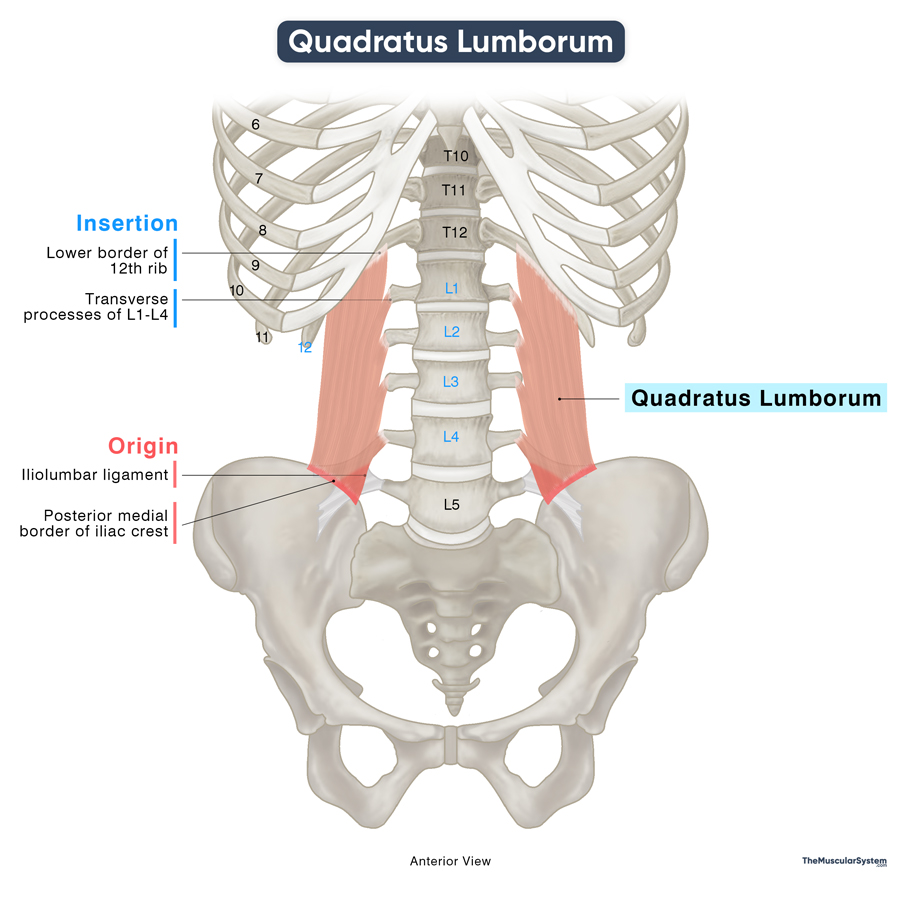Quadratus Lumborum
Last updated:
26/05/2025Della Barnes, an MS Anatomy graduate, blends medical research with accessible writing, simplifying complex anatomy for a better understanding and appreciation of human anatomy.
What is the Quadratus Lumborum
The quadratus lumborum is a paired muscle located on either side of the spine, forming a key part of the posterior abdominal wall. It lies deep within the abdomen, behind the abdominal organs, and is easier to feel from the lower back than from the front due to its depth. The muscle gets its name from its irregular, four-sided quadrilateral shape.
As the largest muscle in the posterior abdominal wall, the quadratus lumborum is important in stabilizing and moving the spine, particularly in the lower back region. Because of its involvement in spinal support and movement, it is often functionally grouped with the back muscles, even though it is anatomically part of the abdominal musculature.
Anatomy
Location and Attachments
| Origin | Posterior medial border of the iliac crest and the iliolumbar ligament |
| Insertion | Transverse processes of the L1-L4 vertebrae and the lower border of the 12th rib |
Origin
The muscle originates via a broad tendon (aponeurotic fibers) from two points: the iliolumbar ligament and the back of the medial border of the iliac crest.
Medical literature sometimes describes it as arising through three distinct layers: anterior, middle, and posterior.
Insertion
From its origin, the muscle courses medially and upwards. As it ascends, the muscle fibers narrow and become tendinous near their points of insertion:
- The anterior and middle layers attach to the lower border of the 12th rib.
- The posterior layer inserts via four small tendons onto the transverse processes of the first four lumbar vertebrae (L1–L4).
Relations With Surrounding Muscles and Structures
The quadratus lumborum forms a large part of the posterior abdominal wall and lies behind the abdominal organs. It is located deep within the body, immediately anterior to the lower back muscles and posterior to key abdominal structures.
Anteriorly, the quadratus lumborum is related to the diaphragm, the psoas major, and the psoas minor (when present). The lateral arcuate ligament of the diaphragm arches over its superior surface. Additionally, the kidneys lie directly in front of the muscle, while the ascending and descending colons are positioned more anterolaterally.
Medially, the lumbar vertebrae and the intertransversarii lumborum muscles are situated next to it.
Posteriorly, the muscle is bordered by the iliocostalis lumborum, a muscle of the lower back.
The quadratus lumborum is enclosed between the anterior and middle layers of the thoracolumbar fascia. The anterior layer covers the surface facing the abdominal cavity, while the middle layer separates it from the deeper back muscles. This fascia also serves as an anchoring point for abdominal wall muscles, providing structural integrity to the posterior abdominal wall.
The iliohypogastric and ilioinguinal nerves cross the anterior surface of the quadratus lumborum. These nerves continue forward to innervate the lateral abdominal wall muscles, including the transversus abdominis, internal oblique, and external oblique.
Function
| Action | Flexing the trunk laterally Extending and stabilizing the lower back Stabilizing the 12th rib to support breathing |
Unilateral contraction (on one side)
- Produces lateral trunk flexion, allowing the body to bend toward the same side. For Example, when you lean sideways to pick something up without bending your knees.
- Elevates and slightly advances the ilium to assist with lifting the leg, such as when climbing stairs or stepping onto a platform.
Bilateral contraction (on both sides)
- Extends the lumbar spine and straightens the lower back.
- Stabilizes the lumbar spine, pelvis, and lumbosacral joints to maintain an upright posture during standing and walking.
- Anchors the 12th rib to support breathing movements and assist the diaphragm during inhalation.
Antagonists
The quadratus lumborum acts with the back muscles, particularly the multifidus and erector spinae group, to extend the lumbar spine and straighten the trunk. Acting in opposition, the abdominal muscles, including the rectus abdominis and the external and internal obliques, function as antagonists by flexing the trunk forward.
Innervation
| Nerve | Subcostal nerve (T12) and L1-L4 lumbar nerves |
The muscle gets innervation from the subcostal nerve arising from T12 vertebrae, and the anterior rami of the upper four lumbar nerves (L1 to L4).
Blood Supply
| Artery | Subcostal, lumbar, iliolumbar, and median sacral arteries |
Blood supply to the muscle comes from the subcostal and lumbar arteries as well as the lumbar branch of the iliolumbar artery. Some additional contribution comes from the median sacral arteries.
References
- Quadratus Lumborum: TeachMeAnatomy.info
- Anatomy, Abdomen and Pelvis, Quadratus Lumborum: NCBI.NLM.NIH.gov
- Quadratus Lumborum Muscle: Kenhub.com
- Quadratus Lumborum: Definition, Function & Innervation: Study.com
- Quadratus Lumborum Muscle: Radiopaedia.org
- Quadratus Lumborum Muscle: Elsevier.com
- Quadratus Lumborum Muscle: GetBodySmart.com
Della Barnes, an MS Anatomy graduate, blends medical research with accessible writing, simplifying complex anatomy for a better understanding and appreciation of human anatomy.
- Latest Posts by Della Barnes, MS Anatomy
-
Rectus Capitis Posterior Minor
- -
Rectus Capitis Posterior Major
- -
Obliquus Capitis Inferior
- All Posts







